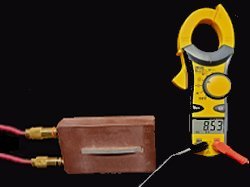
Many players like to know the DC resistance of a pickup as they equate it with actual power output. Unfortunately this is not the case entirely,
for there are other factors involved. Quoting from Bill Lawrence's web site, he talks about the amount of windings, stating
"DC resistance is NOT a power rating; it is the resistance of the wire in a pickup's coil at zero hertz, something that only occurs when the
guitar isn't played. If some marketers use DC resistance as a power rating for an AC device, like a pickup, then they only show their ignorance.
"
He summed it all up rather concisely by stating "DC resistance (Rdc) tells you as much about a pickup's tone and output as the shoe size.
tells you about a person's intelligence!" He closed by stating "tone and output mainly depend on the relation between inductance,
magnetic strength and the efficiency of the pickup, as well as the relation between the inductance of the pickup and the capacitance of the
cable."
However, for those who still wish to know, and as a reference, I have decided to nevertheless show the various readings of the Dan Armstrong
pickups that I have at my disposal.
As can be seen in the upper left, the ST or 'Sustain Treble' pickup comes in with a reading of 9.4K whereas the RT or 'Rock Treble' pickup, seen
upper right gives a reading of nearly 2.7K
Upper left, the JT or 'Jazz Treble' pickup has a very similar reading as the Rock Treble pickup as it comes in
at 2.65K while my JB or 'Jazz Bass' pickup gives a reading of 8.3K.
One of my CB or 'Country Bass' pickups measures in at 8.9K while my second one comes in at 8.6K - somewhat less
than the first one, yet they both exhibit the same sound when slid into the guitar. All of which seems to support
the statements made by Bill Lawrence that DC resistance plays only a part in a pickups strength and sound.

|
At left, and as seen here, my RB or 'Rock Bass' pickup comes in at 8.5K. Of all the single coil units the RB is most impressive for serious
rock sounds. It has a solid, yet juicy punch to it with tremendous harmonics. I can easily get piercing squeals/whistles at virtually any fret
on my Dan guitar. After the ST, the RB is my second favorite pickup. It would be my first except for the usual single-coil hum.
|
Many visitors to the site have noticed that a small amount of Dan Armstrong pickups have gone bad over time and need to be
replaced. Some of the pickups have been altered, making it easy to understand why they have gone bad, but an equal
number of them have just gone bad on their own, with no modifications - leaving many to wonder why.
To a large degree the answer lies in their design. The simple fact that they are interchangeable pickups usually means they get handled a great
deal - much more than pickups that are permanently secured in place on another guitar. As a result, a moderate amount of caution should be
exercised when it comes to the handling of these pickups as a result.

|
At left, is Kent Armstrong's son Aaron, who lives in England. While Kent manufactures and services pickups for Dan Armstrong instruments as well
as other types of instruments in the US, Aaron does the same for the European market. You can read more at their newly designed web site
here.
|
menu
Names and images are TMand © Dan Armstrong / Ampeg. All rights reserved.
All other names and images are TMand © of their respective owners. All rights reserved.
|
| |

